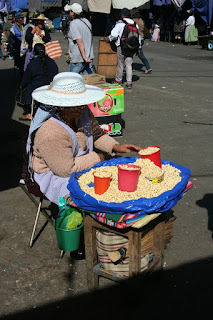Having fully recovered from a 24-hour bug of some form over the weekend, I ventured out with K to La Cancha market this morning.
 |
| Shopping at La Cancha |
The market is where we found the highest concentration of women in traditional dress. All seem to share the same style of pleated skirt and many favour the bowler hat, perched atop the plaited hair, which apparently became fashionable in the 1920s.
 |
| Typical Bolivian outfit |
La Cancha and the neighbouring market that bleed into it are a mixture of crafts '
hecho a mano' clearly aimed at tourists, fresh produce, and more practical items for the locals, as well as lines of stalls serving up hot food. In addition to regular stalls, much of the produce is hawked from makeshift stands comprising a couple of stools, or simply from a rug spread on the side of the road, or by itinerant vendors that wander the market with their wares in hand.
 |
| Beans for sale |
 |
| Street veg |
 |
| Carrot juice: one of your five a day |
If the items for sale are to voluminous or heavy to carry, and the vendor lacks a static pitch, you may find them wheeling them around in a wheelbarrow.
 |
| Err... pigs for sale |
There are no shopping bags to be seen here, as everyone carries their purchases (or items for sale) in 'rucksacks' fashioned from a square of colourful cloth, slung over the shoulders and knotted simply at the front. Everyone seems to have the same or similar patterned cloth and many also double as a baby carrier.
 |
| Colourful cloth hides a tiny face... |
 |
| ...and strains under the weight of a not-so-tiny person |
Most interesting was the food market, as this was still setting up for the day as we arrived. People (mostly women) were scrubbing and peeling vegetables, or tirelessly pounding potatoes, chillies, or tomatoes on a flat mortar. The market was a sensory explosion of boiling pots of soup, blenders juicing fresh fruit, and sellers yelling out the names of the dishes available. Already people lined the benches, tucking into soup and plates of corn and rice.
The hot food stalls serve only savoury meals, but the Bolivians have an incredible sweet tooth. Sugary snacks are much more prevalent than salty ones on every street corner, and grown adults think nothing of picking up a plastic cup filled with jelly and freshly whipped cream to spoon into their mouths on the way home.
 |
| Kids party food |
Fortunately, the market has the sweet end of the spectrum covered too with an extensive display of cakes.
 |
| Cakes arriving |
 |
| But where will we put them? |
 |
| That should just about do it |
We chose to eat at an unlikely vegetarian stall, which we had stumbled upon several days ago. At "El Maná"
comedor vegetariano, we were offered
almuerzo completo for a mere 12bs per person. This 'complete lunch' involved a simple salad (hooray, vegetables!), followed by a soup (potatoes, naturally), and a dish of rice and lentils. It was simple, honest food and filled us up for the rest of the day.
 |
| Salad |
 |
| Potato soup |
 |
| Lentils and rice |
Except, of course, we had to try the local
alfajores.
 |
| Alfajores de manjar blanco |
Alfajores are made in many countries in Latin America, and generally comprise a filling of dulce de leche sandwiched between two biscuits. In Bolivia, however, the specialty seems to be a filling of
manjar blanco - a blancmange-like vanilla custard that has been thickened so that it holds the incredibly crumbly biscuits to it either side.
















No comments:
Post a Comment